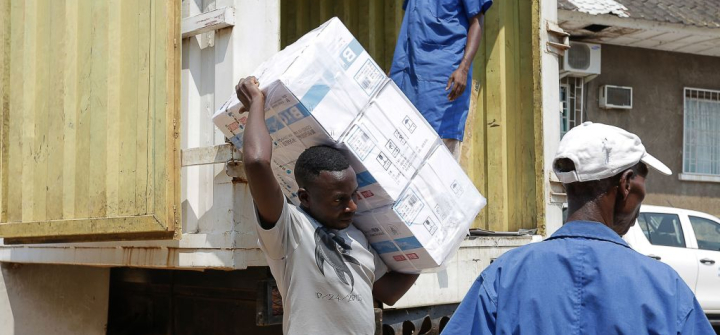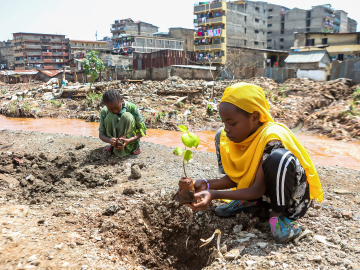Strength Testing the Global Pandemic Treaty
In September 2019, the Global Preparedness Monitoring Board predicted a major respiratory pandemic that would cause millions of deaths and severely damage the global economy. Within a few weeks, the prediction was tragically fulfilled; 3 years on, the COVID-19 pandemic has wreaked havoc, killing millions and causing economic devastation.
The danger of another major pandemic has not receded—if anything, it has worsened. H5N1, mpox, Ebola, and coronaviruses are just a sampling of the array of threats.
We might not know which pathogen will cause the next pandemic, but we do know it is coming. While some progress has been made, the world remains ill-prepared to respond to the extraordinary threat posed by global health emergencies. Despite COVID-19’s lessons on the importance of early detection, containment, information sharing, rapid action, and equity in response measures, effective coordinated global action on this front remains a distant prospect—but it doesn’t have to be this way. 2023 provides an opportunity to change course, and several key reforms are currently underway to strengthen pandemic prevention, preparedness and response.
Within the WHO , countries are negotiating a pandemic treaty to be adopted in 2024. This has the potential to establish a cohesive framework for preparedness, offering direction, stewardship, and accountability—supported by legally binding obligations. In March, the newly established Pandemic Fund at the World Bank will call for proposals for a first round of funding to support low-income countries, which could serve as an important step towards more sustainable, predictable, and scalable financing for preparedness. Meanwhile, countries and other stakeholders are developing proposals for the governance, financing, and equitable access of pandemic vaccines, medicines, genomic surveillance, diagnostics, and personal protective equipment—building capacity where it is most needed and ensuring that these critical countermeasures will be channeled first to those in need, rather than those who can afford to pay. Alongside these initiatives, heads of state and government will gather with other global leaders for a High-level meeting on pandemic prevention, preparedness and response at the UN in September.
The reforms are interconnected and interdependent; each one alone is insufficient. COVID-19 has taught us that preparedness is a collective task for the whole of society. Leaders of nations, international and regional organizations, civil society, and the private sector all have a critical role to play and must be fully engaged in these reforms.
How can we make sure these reforms will be successful? Based on our analysis of the world’s failed response to COVID-19 and other outbreaks, the GPMB has developed 3 tests to assess whether these and other reforms will meet the fundamental requirements to improve global preparedness.
Our first test: Are reforms powered to address the catastrophic threat of pandemics? Reforms must retain the ambition—and make binding commitments--needed to meet the scale of threat that the world is facing. In practice, this requires strong political leadership to bring together all relevant stakeholders to build consensus for bold action.
Second, are reforms designed to deliver equity in access and outcomes, and to ensure coherence within pandemic prevention, preparedness and response? This means establishing systems that are well-coordinated, agile, and able to deliver resources based on need.
Third, is monitoring and accountability embedded in the reforms? Monitoring, including independent monitoring, is key to tracking the causes of health emergencies, identifying gaps and weaknesses in systems, identifying solutions that further equity and bolster the efficiency of systems, and encouraging follow-through on obligations and commitments. It is imperative that monitoring is accompanied by accountability mechanisms that clarify obligations, facilitate implementation, and address noncompliance. For example, the Political Declaration of the HLM on PPPR should drive consensus around the importance of objective, evidence-based and multisectoral monitoring of PPPR, including independent monitoring, and ensure that the role of different actors in delivering outcomes is clearly defined.
We are at a crucial turning point for the future of global preparedness. We must seize this chance to set a course towards a world that is safer from pandemics, epidemics, and other health emergencies. With the right approach and commitments from leaders, the reforms currently underway can be mutually reinforcing—but success depends on a shared recognition of the core principle that no one is safe until we are all safe.
Joy Phumaphi is a former Minister of Health of Botswana and the co-chair of the Global Preparedness Monitoring Board. She previously served as executive secretary of the African Leaders Malaria Alliance, co-chair of the Global Partnership and Fund to End Violence Against Children, and co-chair of the Lancet pathfinder commission on climate change and health.
Bente Angell-Hansen is a Norwegian former diplomat and the interim co-chair of the Global Preparedness Monitoring Board; previously, served as the co-chair of the Open-Ended Working Group on Pandemic Influenza Preparedness of the WHO, playing an instrumental role in the negotiations that led to the successful adoption of the PIP Framework.
Join the 50,000+ subscribers in 170+ countries who rely on Global Health NOW summaries and exclusive articles for the latest public health news. Sign up for our free weekday newsletter, and please share the link with friends and colleagues.
Workers unload boxes of about 500,000 donated doses of China's Sinopharm vaccine. Bujumbura, Burundi, October 14, 2021. Tchandrou NItanga/AFP via Getty






